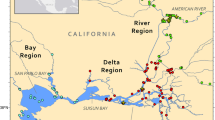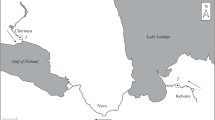Abstract
Upstream-migration of juvenileRhinogobius sp. OR was studied along the Ado River, a tributary of Lake Biwa. Juvenile gobies, mainly 18–21 mm in standard length, migrated from the lake in a belt of about 3 m wide in lower reaches and about 10–20 cm wide in middler reaches. Their upstream-migration was restricted to places shallower than 20 cm with bottom current velocities less than 20 cm/sec. Individual migration speed varied between 4.2–8.9 m/min at places with bottom current velocity of 8.8–20.0 cm/sec, slowing down with increasing current velocity. Most active migration occurred between 14:00 and 16:00, number of upstream-migrating juveniles decreasing with distance from the river mouth. Riffles in the mid-and upper reaches, having few slow current areas, probably present barriers to upstream-migration of the juvenile gobies, although both adults and subadults of the species are distributed in more upper reaches.
Similar content being viewed by others
Literature Cited
Dotu, Y. 1961. The bionomics and life history of the gobioid fish,Rhinogobius giurinus (Rutter). Bull. Fac. Fish. Nagasaki Univ., 10: 120–126. (In Japanese.)
Dotu, Y. and S. Mito. 1955. Life history of a gobioid fish,Sicydium japonicus Tanaka. Sci. Bull. Agr. Kyushu Univ., 15: 213–221. (In Japanese.)
Hidaka, T. and S. Takahashi. 1987. Effects of temperature and daylength on gonadal development of a goby,Rhinogobius brunneus (orange type). Japan. J. Ichthyol., 34: 361–367.
Hynes, H. B. N. 1950. The food of fresh-water sticklebacks (Gasterosteus aculeatus andPygosteus pungitius), with a review of methods used in studies of the food of fishes. J. Anim. Ecol., 19: 36–58.
Iguchi, K. and N. Mizuno. 1990. Diel changes of larval drift among amphidromous gobies in Japan, especiallyRhinogobius brunneus. J. Fish Biol., 37: 255–264.
Iguchi, K. and N. Mizuno. 1991. Mechanisms of embryonic drift in the amphidromous goby,Rhinogobius brunneus. Env. Biol. Fish., 31: 295–300.
Kawanabe, H. and N. Mizuno. (ed.) 1989. Freshwater fishes of Japan. Yama-to-Keikoku-sha, Tokyo. 720 pp. (In Japanese.)
McDowall, R. M. 1988. Diadromy in fishes: migrations between freshwater and marinc environments. Timber Press, London. 308 pp.
Miura, T., T. Sunaga, H. Kawanabe, I. Maki, M. Azuma, S. Tanaka, K. Hirai, T. Narita, Y. Tomoda, N. Mizuno, M. Nagoshi, S. Takamatsu, Y. Shiraishi and Y. Onodera. 1996. Chapter 3. Fishes. Pages 709–906in Biwako Seibutsu-sigen Tyosadan, ed. Interim report of the researches on the biological resources of Lake Biwa. Otsu Hydrobiological Station, Kyoto University, Otsu.
Moriyama, A., Y. Yanagisawa, N. Mizuno and K. Omori. 1998. Starvation of drifting goby larvae due to retention of free embryos in upstream reaches. Env. Biol. Fishes, 52: 321–329.
Murota, T. 1998. Material cycle and sustainable economy, Pages 120–138in R. Keil, D. V. J. Bell, P. Penz and L. Fawcett, eds. Political ecology, Routledge, London.
Nakabo, T. (ed.) 1993. Fishes of Japan with pictorial keys to the species. Tokai University Press, Tokyo. 1474 pp. (In Japanese.)
Tamada, K. 1986. Size variations of a freshwater goby,Rhinogobius brunneus, Cross-band type, along the river length in terms of age and growth. The Nanki Seibutu, 28: 23–34. (In Japanese.)
Yuma, M., K. Hosoya and Y. Nagata. 1998. Distribution of the freshwater fishes of Japan: an historical overview. Env. Biol. Fish., 52: 97–124.
Author information
Authors and Affiliations
About this article
Cite this article
Yuma, M., Maruyama, A. & Rusuwa, B. Behavior and distribution of upstream-migrating juvenilerhinogobius sp. (The orange form). Ichthyological Research 47, 379–384 (2000). https://doi.org/10.1007/BF02674266
Received:
Revised:
Accepted:
Published:
Issue Date:
DOI: https://doi.org/10.1007/BF02674266




